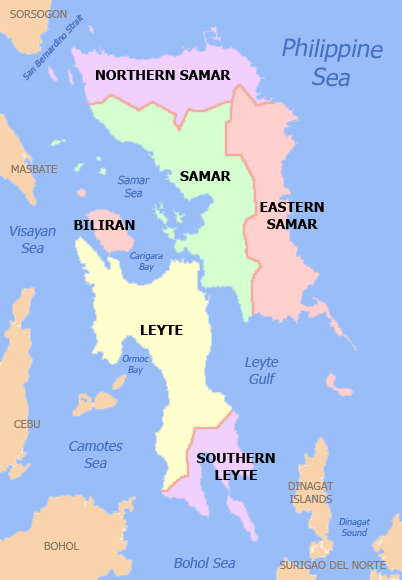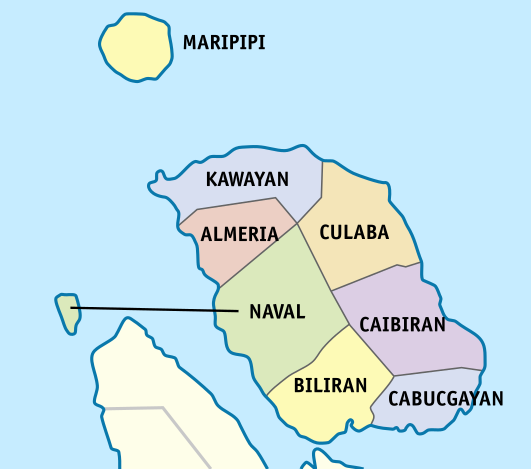|
Leyte
Leyte ( ) is an island in the Visayas group of islands in the Philippines. It is eighth-largest and sixth-most populous island in the Philippines, with a total population of 2,626,970 as of 2020 census. Since the accessibility of land has been depleted, Leyte has provided countless number of migrants to Mindanao. Most inhabitants are farmers. Fishing is a supplementary activity. Rice and corn (maize) are the main food crops; cash crops include coconuts, abaca, tobacco, bananas, and sugarcane. There are some manganese deposits, and sandstone and limestone are quarried in the northwest. Politically, the island is divided into two provinces: (Northern) Leyte and Southern Leyte. Territorially, Southern Leyte includes the island of Panaon to its south. To the north of Leyte is the island province of Biliran, a former sub-province of Leyte. The major cities of Leyte are Tacloban, on the eastern shore at the northwest corner of Leyte Gulf, and Ormoc, on the west coast. Leyte tod ... [...More Info...] [...Related Items...] OR: [Wikipedia] [Google] [Baidu] |
Southern Leyte
Southern Leyte (; Kabalian: ''Habagatan nga Leyte''; ; ), officially the Province of Southern Leyte, is a province in the Philippines located in the Eastern Visayas region. Its capital and largest city is Maasin. Southern Leyte comprised the third congressional district Leyte until it was made into an independent province in 1959. Southern Leyte includes Limasawa, an island to the south where the first Roman Catholic Mass in Philippine soil is believed to have taken place and thus considered to be the birthplace of Roman Catholicism in the Philippines. The province ranks as the second least populated in the region, after the province of Biliran. According to the 2020 census, the province has a population of 429,573. Southern Leyte's geological features created several issues in the province after the flooding of the Subangdaku River and the 2006 mudslide in Guinsaugon. Organizations warned the province it was susceptible to natural occurrences like landslides and floods ... [...More Info...] [...Related Items...] OR: [Wikipedia] [Google] [Baidu] |
Leyte (province)
Leyte (also Northern Leyte; ; Cebuano: ''Amihanang Leyte''; ), officially the Province of Leyte, is a province in the Philippines located in the Eastern Visayas region occupying the northern three-quarters of Leyte Island (with the remaining portion being the province of Southern Leyte). Its capital (and largest city) is the city of Tacloban, administered independently from the province, as well as the regional center of Eastern Visayas. Leyte is thus north of Southern Leyte, south of Biliran, and west of Samar Island. To the west across the Camotes Sea is the province of Cebu. The historical name of the Philippines, "''Las Islas Felipenas''", named by Spanish explorer Ruy López de Villalobos in honor of Prince Philip of Spain, used to refer to the islands of Leyte and Samar only, until it was adopted to refer to the entire archipelago. The island of Leyte is known as Tandaya during the 16th century. Leyte is also known as the site of the largest naval battle in mo ... [...More Info...] [...Related Items...] OR: [Wikipedia] [Google] [Baidu] |
Tacloban
Tacloban ( ; ), officially the City of Tacloban (; ), is a Cities of the Philippines#Legal classification, highly urbanized city on Leyte island in the Eastern Visayas region of the Philippines. According to the 2020 census, Tacloban has a population of 251,881, making it the most populous city in the Eastern Visayas. The city is located southeast of Manila. Tacloban is the regional center of the Eastern Visayas region. It is also the largest city and capital of the province of Leyte (province), Leyte, wherein it is geographically situated and grouped under the province by the Philippine Statistics Authority, but the city is governed and administered independently from it. Tacloban City was briefly the capital of the Philippines under the Commonwealth Government, from October 20, 1944, to February 27, 1945. In an extensive survey conducted by the Asian Institute of Management Policy Center and released in July 2010, Tacloban City ranks as the fifth most competitive city in the ... [...More Info...] [...Related Items...] OR: [Wikipedia] [Google] [Baidu] |
Ormoc
Ormoc (IPA: �oɾˈmok, officially the City of Ormoc (; ; ), is a independent component city in the Eastern Visayas region of the Philippines. According to the 2020 census, it has a population of 230,998 inhabitants, making it the second most-populous city in the province of Leyte after the provincial capital of Tacloban. Ormoc is the economic, cultural, commercial and transportation hub of western Leyte. Ormoc is an independent component city, not subject to regulation from the Provincial Government of Leyte. However, the city is part of the 4th Congressional District of Leyte together with Albuera, Kananga, Merida, Palompon and Isabel, and statistically grouped under the province by the Philippine Statistics Authority. On November 8, 2013, the city was extensively damaged by Super Typhoon Yolanda (Haiyan), having previously suffered severe destruction and loss of life in 1991 from torrential flooding during Tropical Storm Thelma (Uring). Etymology The city's name ... [...More Info...] [...Related Items...] OR: [Wikipedia] [Google] [Baidu] |
Provinces Of The Philippines
In the Philippines, provinces ( or ) are one of its primary political and administrative divisions of the Philippines, administrative divisions. There are 82 provinces at present, which are further subdivided into Cities of the Philippines, component cities and Municipalities of the Philippines, municipalities. The local government units in the Metro Manila, National Capital Region, as well as Cities of the Philippines#Independent cities, independent cities, are independent of any provincial government. Each province is governed by an elected legislature called the Sangguniang Panlalawigan and an elected governor. The provinces are grouped into Regions of the Philippines, eighteen regions based on geographical, cultural, and ethnological characteristics. Thirteen of these regions are numerically designated from north to south, while the National Capital Region, the Cordillera Administrative Region, the Southwestern Tagalog Region (Mimaropa), the Negros Island Region, and the Ba ... [...More Info...] [...Related Items...] OR: [Wikipedia] [Google] [Baidu] |
Eastern Visayas
Eastern Visayas (; ; ; ) is an administrative region in the Philippines, designated as Region VIII. It consists of three main islands: Samar, Leyte, and Biliran. The region has six provinces: Biliran, Leyte, Northern Samar, Samar, Eastern Samar, Southern Leyte, one independent city, Ormoc, and one highly urbanized city, Tacloban (its regional center and largest city). The highly urbanized city of Tacloban is the sole regional center. These provinces and cities occupy the easternmost islands of the Visayas group of islands, hence the region's name. Some historians believe that the oldest ancient kingdom in the Philippines is found in this region, the Lakanate of Lawan, which plays a significant role in the Polynesian and Austronesian intermigration. Eastern Visayas faces the Philippine Sea to the east. The region's most famous landmark is the San Juanico Bridge, which links the islands of Samar and Leyte. As of 2020, the Eastern Visayas region has a population o ... [...More Info...] [...Related Items...] OR: [Wikipedia] [Google] [Baidu] |
Leyte Gulf
Leyte Gulf, also known simply as the Leyte, is a gulf in the Eastern Visayan region in the Philippines. The bay is part of the Philippine Sea of the Pacific Ocean, and is bounded by two islands; Samar in the north and Leyte in the west. On the south of the bay is Mindanao Island, separated from Leyte by the Surigao Strait. Dinagat Island partly encloses the gulf to the southeast, and the small Homonhon Island and Suluan Island, sit astride the eastern entrance to the Gulf. It is approximately north-south, and east-west. Several municipalities are situated on the coast of the gulf: Balangiga, Giporlos, Guiuan, Lawaan, Mercedes, Quinapondan and Salcedo. There are also eleven marine reserves in the gulf region. Leyte Gulf was also the scene of the Battle of Leyte Gulf, which extends to Surigao Strait during the Battle of Surigao Strait, the largest naval battle of World War II and started the end of Japanese occupation in the Philippines. During World War II the gul ... [...More Info...] [...Related Items...] OR: [Wikipedia] [Google] [Baidu] |
Carigara Bay
Carigara Bay (; ), is a large bay in the northern part of Leyte in the Philippines. The bay is bounded by Leyte (province), Leyte to its western, southern and eastern parts. References Bays of the Philippines Landforms of Leyte (province) {{Philippines-geo-stub ... [...More Info...] [...Related Items...] OR: [Wikipedia] [Google] [Baidu] |
Sogod Bay
Sogod Bay is a large bay in the southern part of Leyte Island in the Philippines. An extension of the Bohol Sea, the bay is surrounded by the province of Southern Leyte, and the namesake municipality of Sogod is located at the head of the bay. Panaon Island forms part of the eastern side of Sogod Bay, while Sarangani or Limasawa Island is at the mouth of the bay. Ecology The bay is home to a variety of fishes, is therefore a major fishing ground for the nine municipalities surrounding the bay. Mangko ('' Euthynnus affinis'') is its major fishery resource. Seasonal influx of Mangko has provided food and livelihood to the people of Sogod and nearby municipalities. A study of Sogod Bay by Silliman University in 1994 mentioned that there are seven finfish species that are pelagic and are harvested when they enter the bay. Recently, there have been reports of whale shark sightings in the bay. The Subangdaku River is a major tributary of Sogod Bay, emptying into the bay at th ... [...More Info...] [...Related Items...] OR: [Wikipedia] [Google] [Baidu] |
Biliran
Biliran, officially the Province of Biliran (Waray language, Waray-Waray: ''Probinsya han Biliran''; ; ), is an island province in the Philippines located in the Eastern Visayas Regions of the Philippines, region (Region VIII). Biliran is one of the country's smallest and newest Provinces of the Philippines, provinces. Formerly a sub-province of Leyte (province), Leyte, it became an independent province in 1992. Biliran lies less than a kilometer north of the island of Leyte. A bridge-causeway fixed link over Poro Island in the gateway town of Biliran, Biliran, Biliran connects the province to Leyte. Its capital is the municipality of Naval, Biliran, Naval on the western coast of the island which is the most populous in the province. Biliran is sometimes called "The Singapore of Eastern Visayas" by locals, due to it having a causeway that is similar to that of Singapore's, and also because of its small size and its strategic position in the Visayas Archipelago wherein it is a ... [...More Info...] [...Related Items...] OR: [Wikipedia] [Google] [Baidu] |
Waray People
The Waray people (or the Waray-Waray people) are a subgroup of the larger ethnolinguistic group Bisaya people, who constitute the 4th largest Filipino ethnolinguistic group in the Philippines. Their primary language is the Waray language (also called Lineyte-Samarnon or Binisaya), an Austronesian language native to the islands of Samar, Leyte and Biliran, which together comprise the Eastern Visayas Region of the Philippines. Waray people inhabit most of Samar where they are called Samareños/Samarnons, the northern part of the island of Leyte where they are called Leyteños, and the island of Biliran. In Leyte island, the Waray-speaking people are separated from the Cebuano-speaking Leyteños by the island's mountain range at the middle. In the island-province of Biliran, Waray-speaking people live in the eastern part facing Samar island, and Maripipi Island; their Waray dialect is commonly referred to as ''Biliranon''. In Ticao island, belonging to Masbate province, Bic ... [...More Info...] [...Related Items...] OR: [Wikipedia] [Google] [Baidu] |





